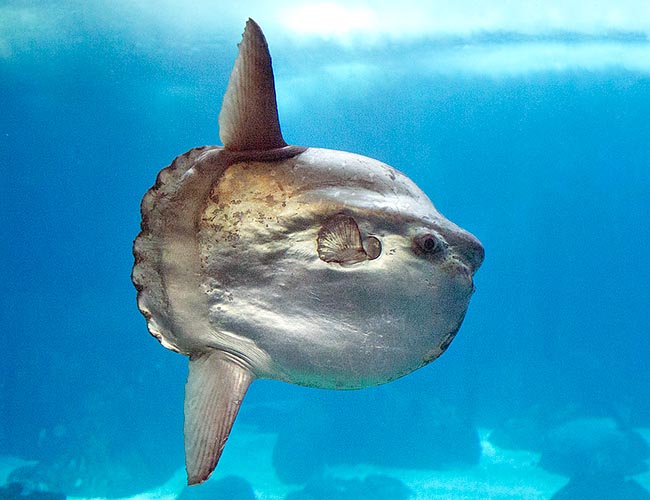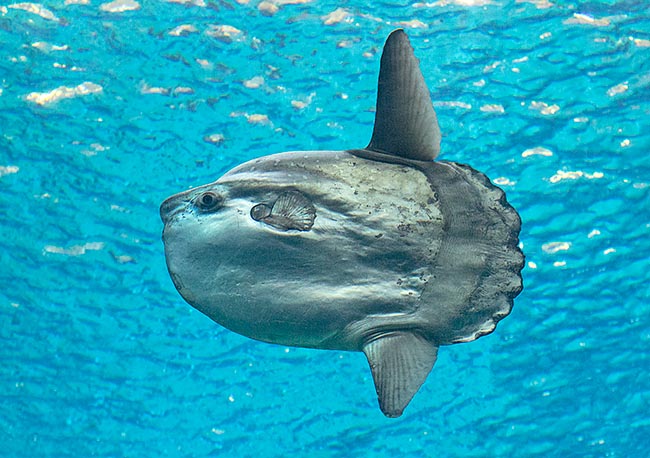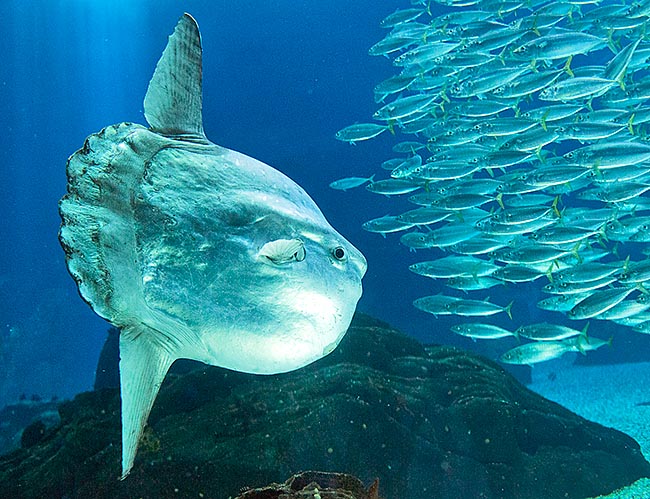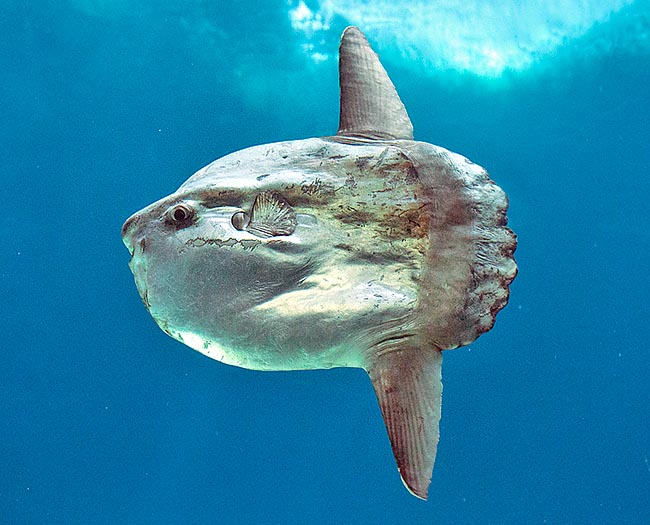Family : Molidae

Text © Giuseppe Mazza

English translation by Mario Beltramini

Mola mola is the biggest extant bony fish with more than 3 m of height and 2 t of weight © Giuseppe Mazza
The Ocean sunfish (Mola mola Linnaeus, 1758) belongs to the class of Actinopterygii, the ray-finned fishes, to the order of Tetraodontiformes and to the family of Molidae which counts only 3 genera: Ranzania (one species only, the Ranzania laevis Pendant, 1776), Mola (two species: Mola mola Linnaeus, 1758 and Mola ramsayi Giglioli, 1883) and Masturus (only one species, the Masturus lanceolatus Liénard, 1840).
The name “mola” attributed to the genus and to the species, means in Latin “millstone, grindstone”, each one of the two overlapping big round stones, which have grooves with sharp edges, once used for grinding, with their rotation, the cereals or for shattering the olives. It is, in short, a fish shaped like a millstone.
Zoogeography
The ocean sunfish is a marine species present in the tropical and subtropical waters of the whole world, Mediter- ranean included, with temperatures between the 12 and 25 °C.
Ecology-Habitat
Usually, it lives offshore, far away from the coasts, but recently a juvenile has remained for three days in the small Larvotto marine reserve, in the Principality of Monaco, and has gone into the deep only after having ended up in the newspapers.

Cosmopolitan, it often surfaces for basking and getting rid of the parasites by the birds © Giuseppe Mazza
Even if it is not equipped with the swim bladder, the ocean sunfish can go down up to 480 m of depth, but it is not rare to see it in surface with the dorsal fin out from the waters and the body almost horizontal while basking. A technique which allows the fish to live also in rather cool zones, getting rid, at the same time, of many parasites thanks to the birds.
Morpho-physiology
Is the biggest extant bony fish, with a record of 3,35 m of length, from the tip of the dorsal fn to the anal one, and with a weight of about two tons.
These are precise figures, concerning a male specimen fished in 1913, and seen that the females are usually bigger, these impressive dimensions might be ex- ceeded.
The oval body, flattened on the sides, is characterized by two huge fins: the dorsal, with 15-18 unarmed rays, and the anal, practically identical, with 14-17 rays. They are united on the back by a sort of a fringe, called “clavus”, which corresponds to the caudal fin and serves as rudder.
These two blades move synchronized from side to side and can advance the fish, when needed, with surprising speed.

Has no swim bladder, but can go down up to 500 m of depth © Giuseppe Mazza
The ventral fins are absent and the pectoral ones, with 12-13 unarmed rays, are rounded, short, spatula-shaped, sustained by a protruding obliquely peduncle, close to the opening of the gills which is reduced to a small circular hole.
The eyes, with silvery iris, are fairly big but the mouth, not protractile, is proportionally very small. The teeth, partly fused together, form a cutting bony beak and the snout has, in the males, an odd fleshy appendage similar to a nose.
The colouration is very much variable. Usually, the two big fins, the back and the caudal part are brown with olive reflections, whilst the rest of the body is more or less silvery.
The skin, thick and rough, is covered by very small, not overlapping scales, practically inexistent, and supported by a cartilaginous layer which protects, like a cuirass, the flabby and watery flesh. It seems to be made of leather, rich of incrustations and scars, and even if it secretes protective mucus it is attacked by various species of parasites, at times even internal.
In 2004, just to say, at the Acores they have found an individual having the oesophagus encrusted by cirripeds, to be precise a colony of Lepas anatifera, which by sure was taking advantage from the transit of the food and the well protected position.

Females may spawn even 300 million of eggs, but it stands in very serious extinction risk © Giuseppe Mazza
Ethology-Reproductive Biology
It is a shy and peaceful fish living solitary or in small schools. It seems that its choice dish is the jellyfishes, but it nourishes also of planktonic crustaceans, echinoderms, salemas, squids and fishes, in particular young eels, not to forget the sea weeds.
The females may spawn even 300 million of eggs, fecundated to the best by the male. The planktonic larvae get through three stages of development, showing traditional fins and spines similar to sea urchins before getting the look of the adults.
In nature the ocean sunfishes are easy preys of the killer whales, of the sea lions and of the sharks. Even if some parts are used in the Chinese medicine, they are not fished because their flesh, little appetible, is also poisonous as is the case of the balloonfishes and the puffers belonging to the same order of the Tetraodontiformes.
This does not prevent the fact, unluckily, that they drop into the nets of the fishing industry and the members of the species are nowadays rapidly decreasing and is listed as “vulnerable” on the Red List.
Synonyms
Tetraodon mola Linnaeus, 1758; Orthragoriscus mola Linnaeus, 1758; Mola aculeata Koelreuter, 1766; Diodon mola Pallas, 1770; Diodon nummularis Walbaum, 1792; Mola rotunda Cuvier, 1797; Orthragoriscus hispidus Bloch & Schneider, 1801; Orthragoriscus fasciatus Bloch & Schneider, 1801; Cephalus brevis Shaw, 1804; Cephalus pallasianus Shaw, 1804; Diplanchias nasus Rafinesque, 1810; Orthragus luna Rafinesque, 1810; Mola aspera Nardo, 1827; Mola hispida Nardo, 1827; Cephalus ortagoriscus Risso, 1827; Diodon carinatus Mitchill, 1828; Pedalion gigas Guilding, 1838; Ozodura orsini Ranzani, 1839; Tympanomium planci Ranzani, 1839; Trematopsis willugbei Ranzani, 1839; Orthragoriscus retzii Ranzani, 1839; Orthragoriscus ghini Ranzani, 1839; Orthragoriscus rondeletti Ranzani, 1839; Orthragoriscus blochii Ranzani, 1839; Orthragoriscus alexandrini Ranzani, 1839; Orthragoriscus redi Ranzani, 1839; Orthragoriscus elegans Ranzani, 1839; Molacanthus pallasii Swainson, 1839; Orthragoriscus lunaris Gronow, 1854; Orthragoriscus analis Ayres, 1859; Aledon storeri Castelnau, 1861; Aledon capensis Castelnau, 1861.
→ For general information about FISH please click here.
→ For general information about BONY FISH please click here
→ For general information about CARTILAGINOUS FISH please click here.
→ To appreciate the BIODIVERSITY of BONY FISH please click here.
→ To appreciate the BIODIVERSITY of CARTILAGINOUS FISH please click here.
